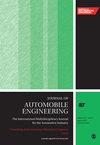Prediction of the classification of the pedestrian landing mechanism in pedestrian-vehicle collisions
IF 1.5
4区 工程技术
Q3 ENGINEERING, MECHANICAL
Proceedings of the Institution of Mechanical Engineers Part D-Journal of Automobile Engineering
Pub Date : 2024-07-23
DOI:10.1177/09544070241259899
引用次数: 0
Abstract
To predict the classification of the pedestrian landing mechanism in pedestrian-vehicle collisions, 1303 reconstructed real pedestrian-vehicle collision cases were selected, and relevant data from before, during, and after the collisions were extracted. A total of 1303 sets of data with eight parameters were obtained via significance analysis, correlation analysis, and collinearity analysis. Then, the Backpropagation Neural Network (BPNN), Genetic Algorithm (GA) optimized BPNN (GA-BPNN), Principal Component Analysis (PCA) optimized BPNN (PCA-BPNN), Principal Component Analysis (PCA) and Genetic Algorithm (GA) optimized BPNN (PCA-GA-BPNN) were used to construct prediction models for the classification of the pedestrian landing mechanism, and the prediction effects were evaluated. The PCA-GA-BPNN model was found to be the optimal model; the prediction accuracies of the pre-collision, in-collision, and post-collision models were 72.4%, 96.4%, and 96.8%, respectively. Further analysis revealed that the optimal model could also accurately predict the classification of the pedestrian landing mechanism in six cadaver experiments. Additionally, the ratio of the pedestrian height to the vehicle hood height ( R行人与车辆碰撞中的行人着地机制分类预测
为了预测行人与车辆碰撞中行人着地机制的分类,选取了 1303 个重建的真实行人与车辆碰撞案例,并提取了碰撞前、碰撞中和碰撞后的相关数据。通过显著性分析、相关性分析和共线性分析,共得到 1303 组数据,其中包含 8 个参数。然后,利用反向传播神经网络(BPNN)、遗传算法(GA)优化的 BPNN(GA-BPNN)、主成分分析(PCA)优化的 BPNN(PCA-BPNN)、主成分分析(PCA)和遗传算法(GA)优化的 BPNN(PCA-GA-BPNN)构建了行人着地机理分类预测模型,并对预测效果进行了评估。结果发现,PCA-GA-BPNN 模型是最优模型;碰撞前、碰撞中和碰撞后模型的预测准确率分别为 72.4%、96.4% 和 96.8%。进一步的分析表明,在六个尸体实验中,最优模型也能准确预测行人着地机制的分类。此外,研究还发现行人高度与车辆引擎盖高度之比(R P-V)会影响模型的预测效果。因此,提出了考虑 R P-V 的改进模型,并发现该模型能显著提高行人前抛机构的预测精度。研究成果为地面相关伤害预测提供了新思路,也为智能车辆的行人保护提供了支持。
本文章由计算机程序翻译,如有差异,请以英文原文为准。
求助全文
约1分钟内获得全文
求助全文
来源期刊

CiteScore
4.40
自引率
17.60%
发文量
263
审稿时长
3.5 months
期刊介绍:
The Journal of Automobile Engineering is an established, high quality multi-disciplinary journal which publishes the very best peer-reviewed science and engineering in the field.
 求助内容:
求助内容: 应助结果提醒方式:
应助结果提醒方式:


